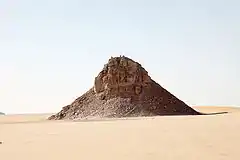Abu Ballas
Abu Ballas (the pottery hill) is an archaeological site in the Libyan Desert of Egypt. It lies about 200 km (120 mi) south-west of the Dakhla Oases and consists of two isolated sandstone cones in the otherwise flat desert. Both hills are covered with Egyptian pottery. These vessels were at the beginning of the 20th century often well preserved, but are today - due to modern tourism - very much destroyed. The site was discovered in 1918 and 1923.[1] More recent research was undertaken in the last years.[2]
 Abu Ballas Rock | |
 Shown within Egypt | |
| Region | New Valley Governorate, Egypt |
|---|---|
| History | |
| Periods | Neolithic Pharaonic |
The area is name giver for the geological Abu Ballas formation.[3]
Neolithic Occupation
Scholars suggest, that the Abu Ballas area has been occupied from about 8700 BP to about 5700 BP. They blame environmental conditions for a sudden cessation of human occupation there.[4]
The Abu Ballas Trail
The nature of this site remained for a long time mysteries. More recent research has shown that the site was a station on an ancient desert road, called Abu Ballas Trail, that connected the Dakla Oasis with the Gilf Kebir and the Jebel Ouenat. Some researchers maintain that Abu Ballas was a milestone of an ancient Egyptian trade route into central Africa or for prospecting minerals[5] The place was installed in the late Old Kingdom or early First Intermediate Period, when some authorities decided to arrange supply depots on a track in the desert. Abu Ballas was one of the largest. Besides the pottery there were discovered some rock carvings, stone tools and even a senet game board engraved on a stone. There are no water sources nearby, evidently all water and food was brought here from the Dakhla Oases with donkeys. Most likely people lived here only for short periods of time. The desert road was mainly in use at the end of the Old Kingdom and to a lesser extent in the Second Intermediate Period and in the New Kingdom.[6]
 Pottery at Abu Ballas
Pottery at Abu Ballas Engraving of bowman
Engraving of bowman Engraving of a cow suckling its calf
Engraving of a cow suckling its calf
References
- H. Kemal l Dine, L. Franchet: Les dépots de jarresdu désert de Lybie, in: Revue scientifique 65 1927), pp.596-600.
- Frank Förster: Beyond Dakhla: The Abu Ballas Trail in the Libyan Desert (SW Egypt), In: Frank Förster, Heiko Riemer: Desert Road Archaeology in Egypt and Beyond, Cologne 2013, ISBN 9783927688414, pp.297-337.
- F. Hendriks; E. Schrank, The marine Abu Ballas formation of southern Egypt: a clay-mineralogic and microfloral reconstruction of the Aptian paleoclimate, Journal of African Earth Sciences, (1990) Volume 10, Issue 3, pp.471-481.
- Rudolf Kuper, Sahel in Egypt: environmental change and cultural development in the Abu Ballas area, Libyan Desert. In: L. Krzyzaniak, M. Kobusiewicz & J. Alexander (eds.), Environmental change and human culture in the Nile basin and northern Africa until the second millennium B.C. Studies in African Archaeology 4 (Poznan: Poznan Archaeological Museum) pp.213–223.
- Discovery of the ancient Abu Ballas Trail Retrieved 2020/04/20.
- Rudolf Kuper, The Abu Ballas Trail: Pharaonic Advances into the Libyan Desert, in: Z.Hawass and L.Pinch Brock (ed.), Egypt and the Dawn of the Twenty-First Century. Proceedings of the Eighth International Congress of Egyptologists, Cairo 2000, vol.2, Cairo 2003, pp.272-276.